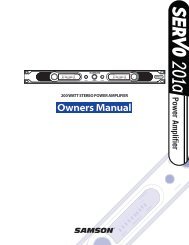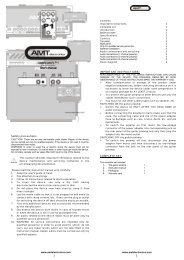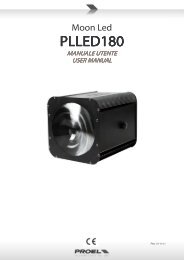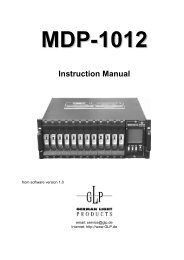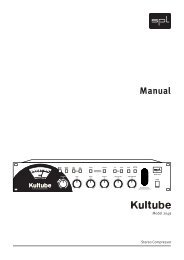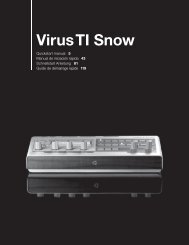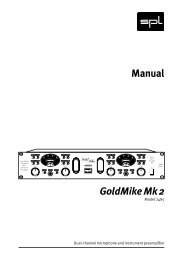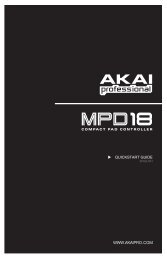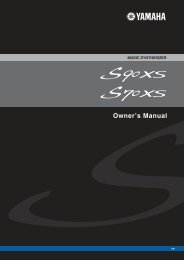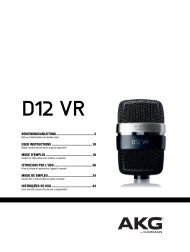FAT FUNKER USER MANUAL
FAT FUNKER USER MANUAL
FAT FUNKER USER MANUAL
Create successful ePaper yourself
Turn your PDF publications into a flip-book with our unique Google optimized e-Paper software.
<strong>FAT</strong> <strong>FUNKER</strong><br />
VALVE FRONT END PROCESSOR<br />
<strong>USER</strong> <strong>MANUAL</strong><br />
GUITAR MONO<br />
TL Audio Ltd, Letchworth, Herts, SG6 1AN, UK<br />
email: info@tlaudio.co.uk<br />
web: http://www.tlaudio.co.uk
TABLE OF CONTENTS<br />
TABLE OF CONTENTS............................................. 1<br />
1. INTRODUCTION ................................................... 3<br />
2. PRECAUTIONS..................................................... 6<br />
3. INSTALLATION ..................................................... 7<br />
AC Mains Supply............................................................ 7<br />
Microphone Input............................................................ 8<br />
Balanced Line Input........................................................ 8<br />
Unbalanced Line Input.................................................... 9<br />
Instrument Input.............................................................. 9<br />
Sidechain Insert Point ................................................... 10<br />
Balanced Output............................................................ 10<br />
Unbalanced Output. ...................................................... 11<br />
Link Connection............................................................ 11<br />
Nominal Operating Level. ............................................ 11<br />
Ventilation..................................................................... 12<br />
Rear Panel. .................................................................... 12<br />
4. OPERATION ....................................................... 13<br />
Input Stage. ................................................................... 13<br />
Microphone Input.......................................................... 14<br />
Line Input...................................................................... 14<br />
Guitar Input................................................................... 15<br />
30dB Pad....................................................................... 15<br />
90Hz Filter. ................................................................... 15<br />
Drive and Peak LEDs.................................................... 16<br />
What is Compression? .................................................. 17<br />
Why Valve Compression? ............................................ 18<br />
Overview of Compressor Operation. ............................ 19<br />
Threshold. ..................................................................... 19<br />
Ratio.............................................................................. 20<br />
Attack and Release........................................................ 21<br />
1
Knee. ............................................................................. 22<br />
Compressor On. ............................................................ 23<br />
Frequency Conscious Compression and Ducking. ....... 23<br />
Gate............................................................................... 24<br />
Stereo Link.................................................................... 26<br />
Equalisation................................................................... 27<br />
LF Band. ....................................................................... 27<br />
LM Band. ...................................................................... 28<br />
HM Band....................................................................... 28<br />
HF Band........................................................................ 29<br />
EQ On. .......................................................................... 29<br />
EQ Pre........................................................................... 29<br />
Output Gain................................................................... 30<br />
Digital Output. .............................................................. 30<br />
5. GETTING STARTED........................................... 32<br />
Connections................................................................... 32<br />
In Use............................................................................ 34<br />
6. SPECIFICATIONS............................................... 37<br />
7. SERVICE............................................................. 41<br />
2
1. INTRODUCTION<br />
Congratulations on purchasing the Fatman Fat Funker<br />
Mono Valve Guitar Front End Processor by TL Audio!<br />
The Fat Funker has been designed to offer guitarists the<br />
ultimate front end for their live or home recording set up,<br />
ensuring great clarity, warmth, depth, intuitive control and<br />
a sound that is as fat as funk!<br />
The Fatman Series utilise low noise solid state electronics<br />
in conjunction with classic valve circuitry to produce audio<br />
processing units offering very high quality signal paths<br />
with the unique valve audio character. This unit offers<br />
comprehensive control facilities whilst remaining easy to<br />
operate, and representing excellent value for money.<br />
The Fat Funker is a single channel guitar processor with the<br />
addition of mic and line inputs in conjunction with the<br />
dedicated guitar instrument input. It features a pre amp,<br />
compressor, a four band equaliser and a noise gate.<br />
A single illuminated VU meter monitors the input level, output<br />
level or the compressor gain reduction. The optional DO-2 digital<br />
output card allows 24-bit analogue to digital conversion via an<br />
RCA phono type SPDIF output, with selectable 44.1 or 48 kHz<br />
sample rates and the option to clock the converter to an external<br />
word clock source. A solid state, electronically balanced input<br />
amplifier is used to achieve state of the art performance with very<br />
low noise, low distortion and wide bandwidth. An ECC83/12AX7A<br />
triode valve stage (run from a stabilised 150v DC supply) is used as<br />
3
a second stage voltage amplifier, to obtain the classic valve sound<br />
and gradual overdrive characteristics.<br />
The preamp stage features 48V phantom power, a 30dB<br />
pad and a high pass 90Hz filter. A Drive LED gives a<br />
visual indication of the signal level through valve stages<br />
(and thus the amount of ‘warming’ taking place) while a<br />
Peak LED warns that clipping is about to occur, and this<br />
monitors the signal at key points in the audio path.<br />
The compressor section offers fully variable control of<br />
threshold, ratio and gain make-up, with four switchable<br />
attack and release times and both hard and soft knee<br />
options. A ‘Hold’ facility reduces LF distortion, and a side<br />
chain insert point is provided for frequency conscious<br />
compression. The gain control element of the Fat Funker’s<br />
compressor stage is based around a special<br />
transconductance amplifier, instead of using VCAs and<br />
helps contribute to the smooth, open sound of the unit. A<br />
stereo link facility is provided to allow the compressor<br />
control voltages of two Fat Funkers to be linked, thus<br />
preventing image shift when processing stereo signals.<br />
A four band valve EQ stage is included (with a triode valve<br />
stage in each filter), providing up to 12dB of cut or boost<br />
and a choice of four pre-selected frequencies on each band.<br />
The ‘EQ PRE’ switch places the EQ ahead of the<br />
compressor in the signal path. A simple but effective noise<br />
gate (with variable threshold) is provided to remove<br />
unwanted background noise.<br />
4
Mic and line inputs are provided on electronically balanced<br />
XLR connectors, and the line input is duplicated on an<br />
unbalanced mono 0.25” jack connector.<br />
Balanced and unbalanced line outputs are provided (on<br />
XLR and jack respectively) and these can be used<br />
simultaneously. The operating level of the line input can be<br />
shifted from -10dB to +4dB (unbalanced) or +4dB to<br />
+18dB (balanced) via a rear panel switch, allowing the Fat<br />
Funker to accept very high levels - such as those from a<br />
digital recorder. The front panel instrument input allows<br />
guitars, basses and keyboards to feed directly into the Fat<br />
Funker, removing the need for a separate DI box.<br />
Please read this manual fully before installing or operating<br />
the Fat Funker.<br />
5
2. PRECAUTIONS<br />
The Fat Funker requires very little installation, but like all<br />
electrical equipment, care must be taken to ensure reliable,<br />
safe operation. The following points should always be<br />
observed:<br />
- All mains wiring should be installed and checked by a<br />
qualified Electrician.<br />
- Ensure the correct operating voltage is indicated on the<br />
rear panel before connecting to the mains supply.<br />
- Never operate the unit with any cover removed.<br />
- Do not expose to rain or moisture, as this may present an<br />
electric shock hazard.<br />
- Replace the fuse with the correct type and rating only.<br />
Warning: This equipment must be earthed.<br />
6
3. INSTALLATION<br />
AC Mains Supply.<br />
The unit is fitted with an internationally approved 3 pin<br />
IEC connector. A mating socket with power cord is<br />
provided with the unit, wired as follows:<br />
Brown: Live.<br />
Blue: Neutral.<br />
Green/Yellow: Earth (Ground).<br />
All mains wiring should be performed by a qualified<br />
electrician with all power switched off, and the earth<br />
connection must be used.<br />
Before connecting the unit to the supply, check that the unit<br />
is set for the correct mains voltage. The unit is internally set<br />
for 110-120V 60Hz or 220- 240V 50Hz operation, and<br />
should only be changed by an authorised service centre.<br />
The mains fuse required is 20mm anti-surge, 1AT rated at<br />
250V. If it is ever necessary to replace the fuse, only the<br />
same type and rating must be used. The power consumption<br />
of the equipment is 25VA.<br />
Warning: attempted operation on the wrong voltage<br />
setting, or with an incorrect fuse, will invalidate the<br />
warranty.<br />
7
Microphone Input.<br />
The microphone input is via 3 pin female XLR connector,<br />
suitable for balanced or unbalanced microphones. The<br />
mating connector should be appropriately wired as follows<br />
for balanced or unbalanced operation:<br />
Balanced inputs:<br />
- Pin 1 = Ground (screen).<br />
- Pin 2 = Signal Phase (also known as “+” or “hot”).<br />
- Pin 3 = Signal Non-Phase (“-” or “cold”).<br />
Unbalanced inputs:<br />
- Pin 1 = Ground (screen)<br />
- Pin 2 = Signal Phase (“+” or “hot”).<br />
- Pin 3 = Signal Ground.<br />
Balanced Line Input.<br />
The Fat Funker has a 3 pin XLR socket on the rear panel,<br />
which will accept both balanced and unbalanced line level<br />
inputs. The mating connector should be appropriately wired<br />
as follows:<br />
Balanced inputs:<br />
- Screen = Ground,<br />
- Tip = Signal Phase (“+” or “hot”),<br />
- Ring = Signal Non-Phase (“-” or “cold”).<br />
Unbalanced inputs:<br />
- Screen = Ground,<br />
- Tip = Signal Phase (“+” or “hot”),<br />
8
- Ring = Ground.<br />
When using unbalanced signals, the signal ground may be<br />
obtained by linking pins 1 and 3 in the mating XLR<br />
connector. If this connection is not made, a loss in level<br />
may result.<br />
Unbalanced Line Input.<br />
An unbalanced line level input at a nominal level of -10dBu<br />
is also provided, on a 0.25” mono jack socket. The mating<br />
plugs should be wired as follows:<br />
- Tip = Signal Phase (“+” or “hot”).<br />
- Screen = Ground.<br />
Instrument Input.<br />
Each channel has a 0.25” jack socket on the front panel (see<br />
Figure 2). A 2 pin (mono) jack plug is required, which<br />
should be wired as follows:<br />
- Tip = Signal Phase (“+” or “hot”),<br />
- Screen = Ground.<br />
9
Sidechain Insert Point.<br />
The sidechain insert point is provided on a 3 pin, 0.25”<br />
switched jack socket on the rear of the unit. The pin<br />
connections are:<br />
- Sleeve = Ground.<br />
- Tip = Send.<br />
- Ring = Return.<br />
The insertion point is unbalanced, and operates at a<br />
nominal level of -2dBu. If used as an additional send only<br />
(e.g. as a send to a tape machine or monitor mixing desk),<br />
the Tip and Ring should be wired together, to preserve the<br />
signal path through the insertion point. When used in this<br />
manner, the send will be post-compressor. Please note that<br />
the sidechain insert is normally used for frequency<br />
conscious compression only and doesn’t break into the<br />
signal path in the same manner as a standard console insert<br />
point. It doesn’t for instance allow you to insert an EQ “inline”<br />
between the Fat Funker line input and compressor<br />
sections.<br />
Balanced Output.<br />
The output is via a balanced, 3 pin male XLR connector.<br />
The mating connector should be wired as follows:<br />
- Pin 1 = Ground (screen).<br />
- Pin 2 = Signal Phase (“+” or “hot”).<br />
- Pin 3 = Signal Non-Phase (“-” or “cold”).<br />
10
Unbalanced Output.<br />
An unbalanced line output is provided on a 0.25” mono<br />
jack socket.<br />
- Tip = Signal Phase (“+” or “hot”).<br />
- Screen = Ground.<br />
Link Connection.<br />
The compressor section stereo link facility is via an<br />
unbalanced jack socket.<br />
The mating connector should be wired as:<br />
- Tip = Signal Phase (“+” or “hot”)<br />
- Screen = Ground.<br />
Note: The link signal is a DC control voltage. Do not<br />
connect the link socket to an audio signal connector. It is<br />
only suitable for connection to the link socket on another<br />
Fat Funker processor.<br />
Nominal Operating Level.<br />
A switch on the rear panel allows the line inputs to be<br />
matched to equipment at a nominal operating level of<br />
+4dBu or -10dBu for unbalanced signals and +18dBu or<br />
11
+4dBu for balanced signals. Most professional equipment<br />
requires +4dBu (approximately 1.2V rms), but some small<br />
mixing consoles, portable tape recorders or domestic audio<br />
equipment require -10dBu (approximately 225mV rms).<br />
Digital multitrack recorders have very high signal levels<br />
due to the digital scale of 0dBfS usually matching +18dBu<br />
in the analogue domain. If a machine of this type is<br />
connected to the Fat Funker line input and distortion is<br />
experienced even at low input gains, then the +18dBu<br />
setting should be selected.<br />
Ventilation.<br />
The Fat Funker may be free standing, or mounted in a<br />
standard 19” rack. Always ensure that the cooling vents on<br />
the front and sides are clear of obstruction, and do not<br />
subject the unit to an external source of heat. If used free<br />
standing, ensure that the equipment is protected against rain<br />
and spillage of liquid.<br />
Rear Panel.<br />
Make sure that all settings, mains and audio connections<br />
have been made as described above before attempting to<br />
operate the equipment.<br />
12
4. OPERATION<br />
Input Stage.<br />
The input gain control sets the level of the mic, line and<br />
guitar signals into the Fat Funker. The signal source is<br />
selected by the 4-position switch above the input gain knob.<br />
Input choices are ‘Mic 48V’ (for condenser microphones<br />
that require phantom power), ‘Mic’ (for dynamic or most<br />
ribbon microphones), ‘Line’ and ‘Instrument’. The<br />
Instrument input allows high impedance instruments such<br />
as guitar or bass etc to connect directly into the Fat Funker<br />
and eliminates the need for a DI (Direct Injection) Box.<br />
A wide range of signals can be fed into the Fat Funker, and<br />
the input gain control also allows the valve stages to be<br />
driven to a variable degree. After the preamp stage the<br />
signal passes through a triode valve stage positioned<br />
between the input circuit and the compression stage.<br />
Increasing the input gain pushes more signal level into the<br />
valve, thus generating more harmonic distortion and<br />
creating that special “valve sound”. At the same time the<br />
output level can be turned down to preserve the same level<br />
at the Fat Funker output, so a choice of sounds is available.<br />
For a more pronounced valve sound, turn up the input gain<br />
and reduce the output gain, and vice versa for a cleaner<br />
sound. Don’t be afraid to push the Fat Funker hard!<br />
As well as driving the valves harder, increasing the input<br />
gain control setting will also have a pronounced effect on<br />
the amount of compression, as the threshold will remain<br />
13
constant as the input level increases. If the input gain is<br />
adjusted the threshold can be re-adjusted accordingly to<br />
maintain a similar amount of compression.<br />
Microphone Input.<br />
When using the Fat Funker with a microphone source, care<br />
should be taken not to apply too much gain at the input.<br />
Start with the input gain control set to minimum and the<br />
output master at the mid-point (12 o’clock position). The<br />
input gain can then be gradually increased until the VU<br />
meter registers about 0VU on normal signal level, when set<br />
to read ‘I/P’. The master output level should then be<br />
adjusted to produce the required output.<br />
CAUTION: Never switch phantom power on or off, or<br />
plug/unplug a microphone with phantom power applied<br />
unless the output level control is turned down. Failure to<br />
do so may result in a thump in your monitor loudspeakers<br />
or PA system.<br />
Line Input.<br />
A line level signal should already be at about the correct<br />
operating level, but this may be checked by monitoring the<br />
level on the output meter, with the compressor bypassed<br />
and the output gain at 0dB. The input gain should be<br />
adjusted until the meter reads about 0VU at normal audio<br />
level, when set to read ‘I/P’.<br />
14
Guitar Input.<br />
The front panel guitar input socket is suitable for low level<br />
sources such as hi impedance microphones, pick ups or<br />
passive guitars and basses, and higher level sources such as<br />
active guitars, basses and keyboards. To cater for this wide<br />
variety of sources, the Fat Funker has a large amount of<br />
gain available, and care should be taken to avoid applying<br />
excessive input gain with a high level source.<br />
30dB Pad.<br />
Occasionally – when using sensitive condenser<br />
microphones – the source signal may be too loud for the<br />
input preamp. In this situation, to avoid any overloading or<br />
distortion of the mic preamp stage, the 30dB pad can be<br />
used to reduce the input gain to a more manageable level.<br />
The 30dB pad only applies to the microphone input.<br />
90Hz Filter.<br />
The high pass filter switch restricts the low frequency<br />
response of the preamp, to effectively remove rumble of LF<br />
noise from the signal. The filter can be useful in restricting<br />
‘popping’ on vocals or even low frequencies caused by<br />
contact with microphone stands or microphone cables.<br />
Popping is an undesirable thump that is caused by closemiking<br />
certain spoken or sung letters, namely “P” or “B”.<br />
These particular letters cause a sudden expulsion of air that<br />
15
can result in an audible thump. As this thump has a lot of<br />
low frequency content the high pass filter can help to<br />
reduce the problem, as can using a pop filter (a device<br />
usually made out of nylon material similar to stockings)<br />
suspended in front of the microphone. The 90Hz filter is<br />
active on the mic, line and guitar inputs.<br />
Drive and Peak LEDs<br />
The yellow Drive LED provides a visual indication of the<br />
signal level through the valve stages, and therefore the<br />
extent of “warming” or valve character being introduced.<br />
The drive LED will gradually illuminate as the input level<br />
or gain is increased, over the range 0dB to +12dB.<br />
The red Peak LED operates as a conventional warning that<br />
clipping is about to occur. The operating level of the entire<br />
signal chain is monitored, and the LED illuminates when<br />
there is less than 5dB of headroom remaining. Normal<br />
operation would be to set the input gain so that the drive<br />
LED is regularly illuminating, with occasional lighting of<br />
the red Peak LED on transients.<br />
If the input and output gain controls are set to their centre<br />
(0dB) positions and there is no EQ boost applied, the Peak<br />
LED will illuminate some 8dB after the Drive LED has<br />
reached its full intensity. However, it is possible to add gain<br />
further down the chain (EQ boost or output level gain),<br />
which will cause the Peak LED to illuminate at a lower<br />
level of Drive. This situation implies that a high level of<br />
“clean” signal is present, without driving the valves hard.<br />
16
What is Compression?<br />
Compression is an essential but often misunderstood<br />
process in modern recording. Put simply, compression<br />
reduces the difference between the loudest and the quietest<br />
levels of an audio signal. This is known as reducing the<br />
“dynamic range” of that signal and is a powerful tool for an<br />
engineer helping to avoid overloading, distortion problems<br />
as well as raising the level of the quieter parts of the audio<br />
signal. Before the introduction of compressors the only way<br />
this could be achieved was by “gain riding”, whereby an<br />
engineer would control the fader manually in order to try<br />
and anticipate very large levels (which might distort the<br />
signal) or very low levels (which may get lost in noise).<br />
The introduction of compression devices meant that this<br />
process could be controlled automatically, allowing the<br />
engineer to get on with more productive jobs!<br />
Many instruments and voices have a very wide dynamic<br />
range that need to be controlled. A singer, for instance, may<br />
be singing quietly one moment and very loudly the next,<br />
and unless compression is applied the vocal won’t “sit”<br />
correctly in the mix, in addition to the problems of<br />
distortion on loud passages and noise on quiet ones.<br />
Compressors effectively turn down the loud bits and turn<br />
up the quiet bits, to achieve a more even and controllable<br />
level.<br />
Compressors are often judged by their ability to control the<br />
dynamics without creating noticeable audible side effects.<br />
Heavy compression can cause the signal to pump or breathe<br />
with the onset and release of the compression.<br />
Some compressor designs can dull the signal and lose the<br />
top end of the signal. The Fat Funker compressor design<br />
17
uses a technology based around a transconductance<br />
amplifier rather than a VCA design. This transconductance<br />
amplifier design is known for being able to retain the full<br />
frequency range and natural character of the audio signal,<br />
even when compressing the signal quite heavily. The Fat<br />
Funker is also capable of more severe compression based<br />
around the optional Hard Knee mode if this is desired.<br />
There are other benefits of compression as well as just<br />
controlling the peaks and raising the quiet parts, applied<br />
properly, it can add punch and excitement to music, as well<br />
as fattening up sounds and creating a more professional<br />
sounding recording. With the Fat Funker, you have the<br />
added benefit of valve stages in the signal path, which<br />
create a warmth and presence just not obtainable with solid<br />
state or digital products. The Fat Funker is exquisite at<br />
compressing guitars and basses.<br />
Why Valve Compression?<br />
Valve compression yields a particularly special sound<br />
which has become very sought after, particularly with the<br />
widespread use of digital products. The reason valve<br />
equipment sounds special is due to two things: harmonic<br />
distortion and natural compression. When the signal<br />
through a valve is increased, it tends to generate a<br />
particular type of subtle and desirable distortion, called<br />
“second harmonic” distortion. This has the effect of<br />
thickening and warming the sound, and the more the level<br />
you feed to the valve stages, the more of this harmonic<br />
distortion will be produced. You should be able to hear this<br />
effect as you increase the Input Gain on the Fat Funker.<br />
18
Secondly, valves will tend to naturally compress an audio<br />
signal, again particularly as the signal level is increased.<br />
This itself also contributes to the warmth produced by the<br />
Fat Funker.<br />
Overview of Compressor Operation.<br />
To operate the Fat Funker successfully an understanding of<br />
each control will help to obtain the best results. If you are<br />
unfamiliar with the effect of compression it may help to<br />
adjust the controls to extreme settings and listen to the<br />
sonic effect. Generally compressors are used in two<br />
different ways: either to enhance the signal and control the<br />
dynamic range as unobtrusively as possible, or used more<br />
severely to specifically create an effect.<br />
Threshold.<br />
The Threshold is the point measured in decibels that any<br />
compression comes into operation. The Threshold control<br />
is variable from +20dB in the most anticlockwise position<br />
to -20dB at the most clockwise position. Any signal below<br />
the Threshold passes through the unit unaffected; while<br />
signals above the Threshold are reduced in gain (and are<br />
thus ‘compressed’). This does depend on the Soft or Hard<br />
knee to some extent as the Soft knee is more gradual<br />
around the Threshold point.<br />
Unlike some compressors, the Threshold control on TLA<br />
units including the Fat Funker starts at a ‘plus’ value in the<br />
counter-clockwise position, and decreases to a ‘minus’<br />
19
value as you rotate the control clockwise. The reason for<br />
this is as you turn the Threshold control on the Fat Funker<br />
clockwise (i.e. towards the negative region) then the degree<br />
of compression will increase. We think this is logical,<br />
whereas the common method of turning the control ‘down’<br />
to achieve more compression is not - but beware, some<br />
other compressors may work in the opposite direction!<br />
Ratio.<br />
Once the input signal has crossed the threshold, the degree<br />
of gain reduction is determined by the Ratio control. The<br />
Ratio control is calibrated in decibels and is simply the<br />
change in output level that results from a given change in<br />
input level. An uncompressed signal will have a 1:1<br />
compression ratio – every 1dB change in input level results<br />
in the same 1dB change in output level. A compression<br />
ratio of 1:3, for instance, means that a 3dB change in input<br />
level will only give a 1dB change in output level. For more<br />
severe compression, simply turn up the Ratio control.<br />
The Fat Funker offers a wide range of ratios from 1:1.5<br />
(gentle compression) through to 1:30 (limiting). Limiting<br />
effectively clamps the input signal at the threshold level no<br />
matter how much the signal is increased: this can be useful<br />
when trying to ensure that the signal doesn’t exceed a<br />
certain level – for instance to prevent a digital recorder<br />
distorting through overload.<br />
20
Attack and Release.<br />
The Attack time sets how quickly the compression is<br />
applied once the threshold has been exceeded, and the<br />
Release time sets how quickly the compression is released<br />
(and the signal returns to normal) once the signal drops<br />
back below the threshold. The Fat Funker Attack and<br />
Release controls each allow a choice of four switched<br />
positions between ‘Slow’ and ‘Fast’. For Attack this covers<br />
the range 0.5mS to 40mS, while the Release control spans<br />
40mS to 4S. There is an element of automatic operation of<br />
the Attack and Release on the Fat Funker: for instance,<br />
should a very short transient occur the time constants tend<br />
to become shorter, to prevent a slow release leaving a<br />
“hole” in the signal after the transient. Also, a fast release<br />
setting will be extended by a slow attack setting. Due to<br />
this automatic nature of the time constants, the controls are<br />
simply labelled ‘Slow’ to ‘Fast’.<br />
The speed of the Attack and Release should in general be<br />
able to work with the tempo of the signal. For example if<br />
the signal is a snare drum, by monitoring the gain reduction<br />
it is possible to set the Release to allow the compression to<br />
fully recover (i.e. the gain reduction needle will settle back<br />
to 0dB) before the next snare beat. This prevents the second<br />
snare beat being reduced in level in comparison to the first.<br />
One side-effect of having an incorrect release setting is<br />
distortion on low frequency signals, which can particularly<br />
occur when using a fast release setting on bass heavy<br />
signals – the compressor is forced in and out of<br />
compression during one cycle of the waveform, and<br />
distortion results. The Fat Funker has a built-in “Hold”<br />
facility which delays the onset of release for approximately<br />
21
10mS after the input signal falls below the threshold. If<br />
distortion is still experienced, a slower release time should<br />
be used.<br />
Knee.<br />
The Knee switch enables the Fat Funker to be operated in<br />
two different modes – soft Knee or hard Knee. Soft knee<br />
mode offers a gentle compression curve around the<br />
threshold point, and is traditionally employed to yield a<br />
more subtle, musical type of compression effect. The hard<br />
knee setting causes the full compression ratio to be applied<br />
immediately the signal has passed the threshold point, so<br />
tends to produce more pronounced and severe compression.<br />
Gain Make Up.<br />
While the subjective sound quality of the signal can be<br />
improved by compression, the overall signal level will be<br />
reduced when gain reduction is taking place. The Gain<br />
Make Up control is designed to boost the compressed<br />
signal by between 0 and 20dB, in order to bring back the<br />
level to the same loudness as the uncompressed signal.<br />
Without this control, comparing the original and<br />
compressed signals becomes difficult, since there would be<br />
a level drop each time the compressor is switched in:<br />
therefore it is normal to adjust the Gain Make Up control so<br />
that when the ‘compressor on’ switch is activated, the audio<br />
signal remains constant in level.<br />
22
Unlike the Output Level control, the Gain Make Up control<br />
is active only when the ‘compressor on’ switch is engaged.<br />
Once the Gain Make Up has been adjusted, use the Output<br />
Level control to set the overall output level of the Fat<br />
Funker.<br />
Compressor On.<br />
This switch enables or disables the compressor stage, thus<br />
allowing an A/B comparison to be made between the<br />
original untreated signal and the compressed signal. Any<br />
gain make up applied to the signal only becomes active<br />
when the “Compressor On” is enabled. An associated status<br />
LED indicates when the compressor is active. The Gain<br />
Reduction on the VU meter will monitor the level of<br />
compression regardless of the compressor stage being<br />
active or non active.<br />
Frequency Conscious Compression and Ducking.<br />
The provision of a sidechain insert point on the Fat Funker<br />
allows the unit to perform frequency conscious<br />
compression, such as ‘de-essing’. This is achieved by<br />
patching an equaliser (normally a parametric or graphic<br />
type) into the sidechain (the insert point works on a sendand-return<br />
principle whereby the insert ‘send’ connects to<br />
the equaliser input, and the equaliser output connects to the<br />
insert ‘return’, thus completing the circuit). Once<br />
23
connected, any frequency boosted on the equaliser will<br />
effectively lower the compression threshold at that<br />
frequency. To de-ess, for instance, use a parametric EQ<br />
patched into the insert point and try boosting the sibilant<br />
frequency (normally 3-5kHz) using a narrow bandwidth<br />
setting on the EQ. This should make the Fat Funker more<br />
sensitive to the boosted frequency, thus compressing it to a<br />
greater degree. The sidechain can also be used for ducking<br />
a signal. By running the bass guitar through the Fat Funker<br />
and then putting the kick drum through the sidechain input,<br />
it will make the compressor kick in when the kick drum<br />
sounds thus ‘ducking’ the bass on these occasions.<br />
Gate.<br />
A gate (or noise gate) is a device that can completely shut<br />
off or mute the signal path in order to prevent unwanted<br />
low level signals from passing. The closing of the Fat<br />
Funker gate is triggered by the level of the input signal<br />
falling below an adjustable threshold point (in this case the<br />
threshold is adjusted by the ‘Gate’ control over the range -<br />
10dB to ‘OFF’). Gates are commonly used to shut out<br />
background noise or hiss from noisy signals or to isolate a<br />
louder signal from other quieter signals. An example of this<br />
would be when miking up a drum kit with a number of<br />
individual mics on specific drums. Each mic will pick up<br />
not only the drum it is directly miking but also all the<br />
neighbouring drums. By gating out the quieter<br />
neighbouring drums each drum track can be “cleaned up”.<br />
The trick to using the gate successfully is to adjust the<br />
threshold to the point where the desired signal opens the<br />
24
gate and the undesirable signal is below the threshold point<br />
and is gated out. This is never an easy task as the threshold<br />
point remains constant but the point between desirable<br />
signal and undesirable signal is continuously changing.<br />
Gating can be a tricky process to get right as success<br />
depends a great deal on the signal characteristics.<br />
The gate on the Fat Funker is situated before the<br />
compressor stage and has a red LED indicating when the<br />
gate is active (i.e. shut). At the fully anti-clockwise position<br />
the gate is at its ‘off’ position and is completely inactive.<br />
Turning the gate clockwise towards the -10dB maximum<br />
setting raises the threshold point so that the signal needs to<br />
be increasingly louder (as the threshold is raised) to open<br />
the gate. At the lowest setting, just above the ‘off’ position,<br />
low level signals such as background noise can be gated.<br />
Raising the threshold point allows gating of higher level<br />
signals such as drums. If you are having trouble selecting<br />
the threshold point, one tip is to select different threshold<br />
points suitable for specific parts of the signal and mark<br />
them with a chinagraph pencil. For example the intro to the<br />
signal may be quite strong - so the threshold can be set<br />
quite high - and the end of the signal may have a gradual<br />
fade out, so the threshold can then be adjusted to suit this<br />
ending. This of course is only practical with recorded<br />
signals where the track can be constantly replayed to<br />
practice the settings.<br />
25
Stereo Link.<br />
Two Fat Funkers can be used to process a stereo signal by<br />
inserting a link cable between the two (see section 3.9) and<br />
depressing the ‘Link’ switch on both units. This feature<br />
Iinks the compressor control voltages of the two units,<br />
ensuring that the same amount of gain reduction is applied<br />
to both - even if the signal exceeds the threshold on one<br />
side only.<br />
Stereo linked compression is essential to avoid imbalances<br />
in the stereo image (known as “dips”) to appear on one side<br />
of a stereo signal, if the signal exceeds the threshold on that<br />
side only. If a compressor has not been stereo linked, the<br />
“dipping” of one channel can sound very obvious and<br />
unnatural. In linked mode, if either signal crosses the<br />
threshold setting, both channels will react together and will<br />
be compressed by the same amount. For best results, both<br />
channel settings should be made the same to maintain a<br />
consistency over the stereo image.<br />
A variation on this is when two units are used to perform<br />
Ducking or Gating, where the gain of one Fat Funker is<br />
controlled from another, but without reciprocal action. This<br />
is useful where one Fat Funker is used to reduce the gain of<br />
background music when the microphone signal is present,<br />
for example. The link cable should be fitted, as for stereo<br />
operation, but the Link switch should only be engaged on<br />
the ‘slave’ Fat Funker (the background music channel in<br />
the example above). If the compressor is switched out on<br />
the ‘master’ unit, gain reduction will only occur on the<br />
slave unit. The threshold and ratio controls on the master<br />
26
Fat Funker will determine the amount of compression<br />
performed by the slave.<br />
Equalisation.<br />
The Fat Funker equaliser section has four bands, each with<br />
a continuously variable cut and boost control. Each band<br />
has a four position switch to select the nominal corner<br />
frequency for the shelving bands (LF and HF), or centre<br />
frequency for the peaking mid bands (LM and HM). The Q<br />
(or bandwidth) of the equalisers is approximately 0.5 (2<br />
octaves), giving a broad effect and allowing a good degree<br />
of overlap between bands. Remember that there is a good<br />
deal of gain available from the EQ section, and greatly<br />
boosting one or more bands can cause the red Peak LED to<br />
illuminate as the Fat Funker is driven towards clipping. In<br />
this case you need to compensate by bringing down the Fat<br />
Funker output level control until the Peak LED is<br />
extinguished.<br />
LF Band.<br />
The LF (Low Frequency) band of the equaliser has a<br />
shelving characteristic - i.e. it extends from the selected<br />
frequency to the extreme low frequency limit of the<br />
equaliser’s response.<br />
The corner frequency of the LF band is selected by a rotary<br />
switch from 60Hz to 500Hz, and the cut or boost is<br />
controlled by a continuously variable, centredetented rotary<br />
27
knob. At the selected corner frequency, up to 12dB of cut<br />
and boost are available. The slope of the shelf is<br />
12dB/octave, and typical response curves are shown in the<br />
specification section of this manual.<br />
LM Band.<br />
The LM (Low-Mid Frequency) band has a peaking<br />
characteristic - i.e. it boosts or cuts a section of the audio<br />
spectrum around its selected centre frequency only. The<br />
centre frequency of the LM band is selected by a rotary<br />
switch from<br />
250Hz to 2.2kHz. The mid bands possess a fairly low Q<br />
value of approximately 0.5, for a response which results in<br />
effective equalization without harshness, and is likely to<br />
add depth when a boost is applied rather than pushing out<br />
any unwanted frequencies.<br />
The amount of cut or boost is again controlled by a<br />
continuously variable, centre-dented rotary knob, with up<br />
to 12dB of cut and boost available at the centre frequencies.<br />
Response curves for the mid bands are also shown in the<br />
specification section of this manual.<br />
HM Band.<br />
The HM (High-Mid Frequency) band is similar in operation<br />
to the LM band, except that the centre frequencies are<br />
obviously higher and concentrated in the critical upper<br />
vocal region of the spectrum. The available frequency<br />
range is 1.5kHz to 5kHz.<br />
28
HF Band.<br />
The HF (High Frequency) band has a shelving<br />
characteristic, complimenting the LF band. Corner<br />
frequency selection is by rotary switch from 2.2kHz to<br />
12kHz.<br />
EQ On.<br />
The ‘EQ On’ switch allows the EQ section to be bypassed<br />
for comparison of the equalised and original, unprocessed<br />
signal.<br />
EQ Pre.<br />
The ‘EQ Pre’ switch places the equaliser ahead of the<br />
compressor section in the signal path. This enables more<br />
flexibility in sound, since the compressor will become more<br />
sensitive to any frequencies that have been boosted by the<br />
EQ section. The effect may be compared by toggling the<br />
EQ Pre switch.<br />
29
Output Gain.<br />
This controls the level at the Fat Funker output. The<br />
nominal level is 0dB at the centre detented position. This<br />
control effectively acts like an output fader, and is very<br />
useful when recording direct to tape or hard disc through<br />
the Fat Funker. You may find that some digital recorders<br />
require a good deal of input level in order to register a 0dB<br />
reading on their meters (+18dBu analogue usually matches<br />
0dBFS in the digital domain). This is normal, since many<br />
digital recorders are designed to preserve headroom and<br />
keep the signal well below the 0dB clip point - thus<br />
preventing the recorder distorting. The Fat Funker provides<br />
a further 15dB of gain at the output fader to drive digital<br />
recorders. It is important to distinguish the difference<br />
between the output gain knob and the gain make-up knob in<br />
the compressor section. The gain make-up control is only<br />
active when the compressor is switched on, whereas the<br />
output gain control is always active but will have no effect<br />
on the compression characteristics of the signal.<br />
Digital Output.<br />
The digital output is an option for the Fatman Fat Funker.<br />
The DO2 card converts the analogue signal at 24-bit<br />
resolution and is selectable to 44.1 or 48 kHz sample rates.<br />
The digital connector is a coaxial SPDIF format on an RCA<br />
phono type connector. The card also has a word clock BNC<br />
connector for clocking to an external digital source. This is<br />
30
useful for ‘slaving’ the Fat Funker A/D card to an existing<br />
digital setup without the Fat Funker needing to be the<br />
digital master in the system.<br />
31
5. GETTING STARTED<br />
Connections.<br />
There are various ways that the Fat Funker can be<br />
connected into your signal path. The three most common<br />
are:<br />
a) As an guitar front end<br />
b) Connected to a channel insert point on a mixing desk<br />
c) Connected to a group or master insert point on a mixing<br />
desk<br />
To use the Fat Funker as an instrument front end, connect<br />
the output of the Fat Funker directly to the line (not mic)<br />
input of your console, recorder, PA or sound card. A<br />
common mistake is to plug the Fat Funker line output into<br />
the XLR mic input of a console. This will cause the console<br />
mic inputs to overload very easily and may result in a loss<br />
of quality.<br />
Once the output is connected in the way that you desire,<br />
simply feed your mic, guitar or instrument into the relevant<br />
input on the Fat Funker. You are also able to record direct<br />
to a multitrack recorder (thus bypassing the console). This<br />
is a common technique these days as it keeps the signal<br />
path short, and of the highest quality. No unnecessary<br />
console stages are passed through, thus maintaining quality.<br />
Many mixers have sockets called ‘insert points’, which<br />
allow processors such as dynamics devices and EQs to be<br />
patched in-line into the mixer signal path at various points.<br />
32
The mixer’s channel insert point usually ‘sends’ the input<br />
signal out directly after the mixers preamp stage- allowing<br />
connection to the line input of the Fat Funker - and then<br />
returns the processed signal from the line output of the Fat<br />
Funker back into the mixer at the same point in the signal<br />
path.<br />
This is commonly achieved using a special insert cable<br />
(sometimes known as a ‘Y’ lead or split lead is usually a<br />
stereo 0.25” jack connector at one end split into two mono<br />
jack or XLR connectors – one for send and one for return).<br />
The most likely positions that insert points are located on a<br />
mixer are in the channel, group and stereo master sections.<br />
Patching the Fat Funker into the channel insert point means<br />
that any signal passing through that channel will pass<br />
directly though the Fat Funker. Compressing an off-tape<br />
signal on mixdown, for instance, can be achieved by<br />
connecting the tape machine to the mixer tape returns, then<br />
connecting the Fat Funker into the relevant console channel<br />
insert point. The off-tape signal will then be fed into the Fat<br />
Funker’s line input via the mixer insert ‘send’ connection.<br />
The line output of the Fat Funker connects back to the<br />
insert ‘return’ connection, thus returning the processed<br />
signal to the mixer and ensuring continuous signal flow.<br />
Group insert points are used to process sub-grouped signals<br />
such as drums or backing vocals. It’s possible to mix a<br />
group of voices or instruments to a single group, and then<br />
use that group fader to control the overall level, rather than<br />
having to adjust each individual voice or instrument level.<br />
If you then wish to compress the overall group signal, you<br />
can connect a Fat Funker to the relevant group insert point,<br />
using the same ‘send and return’ technique as the channel<br />
insert.<br />
33
The optional digital output (via the DO-2 card) will allow<br />
high quality 24-bit A/D conversion of the Fat Funker mono<br />
output on a coaxial SPDIF connector. The DO-2 can feed<br />
directly into digital recorders such as Digital Multitrackers,<br />
Soundcards / Hard Disk Recorders, DAT Recorders,<br />
Minidisk and CD-Recorders, bypassing any A-D<br />
conversion stages on the way. When connecting the DO-2’s<br />
SPDIF output it is advisable to use cables less than 5<br />
metres in length and of high quality. The digital output can<br />
be used simultaneously with the Fat Funker’s analogue<br />
output.<br />
In Use.<br />
Having connected the Fat Funker, it’s time to put it into<br />
action! Here’s a simple step by step guide (this is laid out<br />
purely as an example of what you can do with your unit and<br />
should not limit you from operating it in a different<br />
fashion):<br />
Setting up a microphone<br />
1. We’ll assume that a condenser microphone is connected<br />
to the Fat Funker<br />
mic input, and the +48V phantom power is engaged. The<br />
first stage is then to set up the gains of the Fat Funker. With<br />
the compressor, EQ and gate stages switched out, start with<br />
the Fat Funker input gain at minimum and output gain at<br />
0dB.<br />
2. Gradually bring up the Fat Funker input gain until the<br />
Drive LED illuminates with the chosen source material -<br />
34
this should also generate a healthy reading on the Fat<br />
Funker VU meter (when set to ‘I/P’). Then switch to meter<br />
‘O/P’ and check that around 0VU is being produced, and<br />
adjust the output level control if necessary.<br />
3. Try engaging the 30dB pad and 90Hz filter switches.<br />
You should notice that the pad greatly reduces the mic gain<br />
and the filter reduces the LF response of the mic (try those<br />
‘B’ and ‘P’ letter sounds as outlined in section 4.6).<br />
4. Now depress the Compressor ‘On’ switch, and using the<br />
compressor controls you will need to adjust settings to suit<br />
the input you are listening to. A good starting point is set<br />
the Attack and Release to ‘Fast’, Ratio to 1:3, Knee to<br />
‘Soft’, and Threshold to +20dB.<br />
5. As you start turning the Threshold control clockwise<br />
towards 0dB, the Fat Funker meter should now register that<br />
some gain reduction is taking place. Aim to get around a<br />
maximum 3-4dB of gain reduction occurring as a starting<br />
point, by lowering the Threshold further if necessary. You<br />
should also notice that increasing the Ratio setting causes<br />
more gain reduction to occur.<br />
6. When gain reduction is taking place, you should notice<br />
that the output level is reduced. By switching the<br />
compressor ‘in’ and ‘out’, you can compare the levels and<br />
the subjective sound quality of the original and compressed<br />
signals. With the compressor active, use the Gain Make-<br />
Up control to set the level so that when disabling the<br />
compressor, there is no level drop. This way you can A/B<br />
the original and compressed signals without the levels<br />
changing.<br />
7. At this stage if you are unfamiliar with compression you<br />
should experiment with each control to see how it affects<br />
the sound. If in doubt, aim to use compression gently as it<br />
35
can be difficult to compensate for over-compression, if you<br />
later decide that too much effect was used.<br />
On the other hand there are no rules, so if extreme settings<br />
get you the effect you are after, the choice is yours. Let<br />
your ears be the guide.<br />
8. Try setting the gate so that it opens when phrases are<br />
sung or spoken into the mic. Do this by starting at the<br />
‘OFF’ position and raising the threshold gradually. You<br />
should find as the threshold is raised that the effect of the<br />
gate becomes more severe.<br />
9. Engage the EQ section and experiment with applying<br />
some EQ. You should find that the LF & HF bands are<br />
useful for adding some low end ‘warmth’ and high end<br />
‘air’, while the mid bands are more useful at removing<br />
‘boxiness’ or nasal tones from mic sources. Unlike other<br />
EQ’s, you should find that you can apply quite drastic<br />
amounts of EQ boost and the unit will still retain its<br />
musicality – and not introduce unwanted harshness.<br />
36
6. SPECIFICATIONS<br />
Microphone Input: Gain range +16dB to +60dB,<br />
Noise -127dBu (EIN with 150 ohm source,<br />
22Hz - 22KHz and maximum gain),<br />
Switchable 30dB pad,<br />
Maximum input level +4dBu (+30dBu with pad).<br />
Phantom Power: +48V at 10mA maximum.<br />
Line Inputs: Balanced XLR, switchable +4dBu/+18dBu<br />
nominal level.<br />
Unbalanced jack, switchable -10dBu/+4dBu nominal.<br />
Gain range +/-20dB.<br />
Maximum input level +26dBu.<br />
Instrument Input: Via front panel 0.25” jack socket,<br />
Input Impedance 1Mohm,<br />
Gain range -2dB to +38dB,<br />
Maximum input level +10dBu.<br />
High Pass Filter: -3dB at 90Hz, 12dB per octave, Active<br />
on all inputs.<br />
Outputs: Balanced XLR, nominal level +4dBu,<br />
Unbalanced jack, nominal level -10dBu.<br />
Output Gain Control: Rotary fader, +15dB maximum<br />
gain.<br />
37
Maximum Output Level: +26dBu (XLR), +12dBu<br />
(Jack).<br />
Gate: Threshold variable -60dBu to -10dBu.<br />
Compressor: Threshold -20dBu to +20dBu,<br />
Attack 0.5msec to 40msec,<br />
Release 40msec to 4 seconds,<br />
Ratio 1:1.5 to 1:30,<br />
Hard / Soft Knee switch,<br />
Gain Make-Up 0 to +20dB.<br />
Equaliser:<br />
LF Band: +/-12dB at 60Hz to 500Hz.<br />
Shelving response.<br />
LM Band: +/-12dB at 250Hz to 2K2Hz.<br />
Peaking response, Q = 0.5.<br />
HM Band: +/-12dB at 1K5Hz to 5KHz..<br />
Peaking response, Q = 0.5.<br />
HF Band: +/-12dB at 2K2Hz to 12KHz.<br />
Shelving response.<br />
Drive LED: Increasing intensity to reflect valve drive,<br />
commencing at +4dBu to full brightness at<br />
+14dBu (Output level control at 0dB).<br />
Peak LED: +20dBu. Monitors Input and Output Levels.<br />
38
VU Meter: Switchable to Input level, (0VU = +4dBu),<br />
Output level, (0VU = +4dBu),<br />
Output +10dB, (0VU = +14dBu),<br />
Gain Reduction (Compression).<br />
Frequency Response: 10Hz to 40KHz, +0, 1dB.<br />
Distortion: Predominately second harmonic, increasing<br />
with “Drive” level. Typically 0.2% @ 0dBu.<br />
Noise: -80dBu, 22Hz to 22KHz, line input selected at<br />
0dBu input and output gain, Compressor and EQ on at 0dB.<br />
Dynamic Range: 106dB (Line input @ 0dB gain).<br />
Sidechain Insertion Points: Unbalanced, switched 3 pin<br />
jack socket,<br />
tip = send, ring = return,<br />
Nominal level -2dBu,<br />
Output impedance 47 ohms,<br />
Return input impedance 10Kohms.<br />
Power Requirements: Internally set to 230V 50Hz or<br />
115V 60Hz operation,<br />
Detachable IEC power cord,<br />
Power consumption 25VA typical.<br />
Dimensions: 19” rack mounting, 2U high.<br />
W x D x H = 483 x 88 x 200mm (19.0” x 7.9”<br />
x 3.5”).<br />
39
Shipping Weight: 6 kgs.<br />
.<br />
40
7. SERVICE<br />
Should the Fat Funker require service, it must be taken or<br />
posted to an authorized dealer with a description of the<br />
fault. Please retain the original packing for possible future<br />
use, and ensure the unit is suitably protected during transit.<br />
The manufacturer cannot accept responsibility for damage<br />
caused during transportation.<br />
The Fat Funker is supported by a limited warranty for a<br />
period of one year from the date of purchase. During this<br />
period, any faults due to defective materials or<br />
workmanship will be repaired free of charge. The warranty<br />
excludes damage caused by deliberate or accidental misuse,<br />
tampering, operation on the incorrect mains voltage, or<br />
without the correct type and value of fuse fitted. It is the<br />
user’s responsibility to ensure fitness for purpose in any<br />
particular application. The warranty is limited to the<br />
original purchase price of the equipment, and excludes any<br />
consequential damage or loss. When claiming service under<br />
warranty, proof of purchase date must be included with the<br />
equipment for repair.<br />
Please record the following details, and retain proof of<br />
purchase:<br />
Serial Number.............................<br />
Date purchased...........................<br />
Dealer.........................................<br />
TL Audio Limited,<br />
Iceni Court,<br />
Letchworth, SG6 1TN, England.<br />
41



